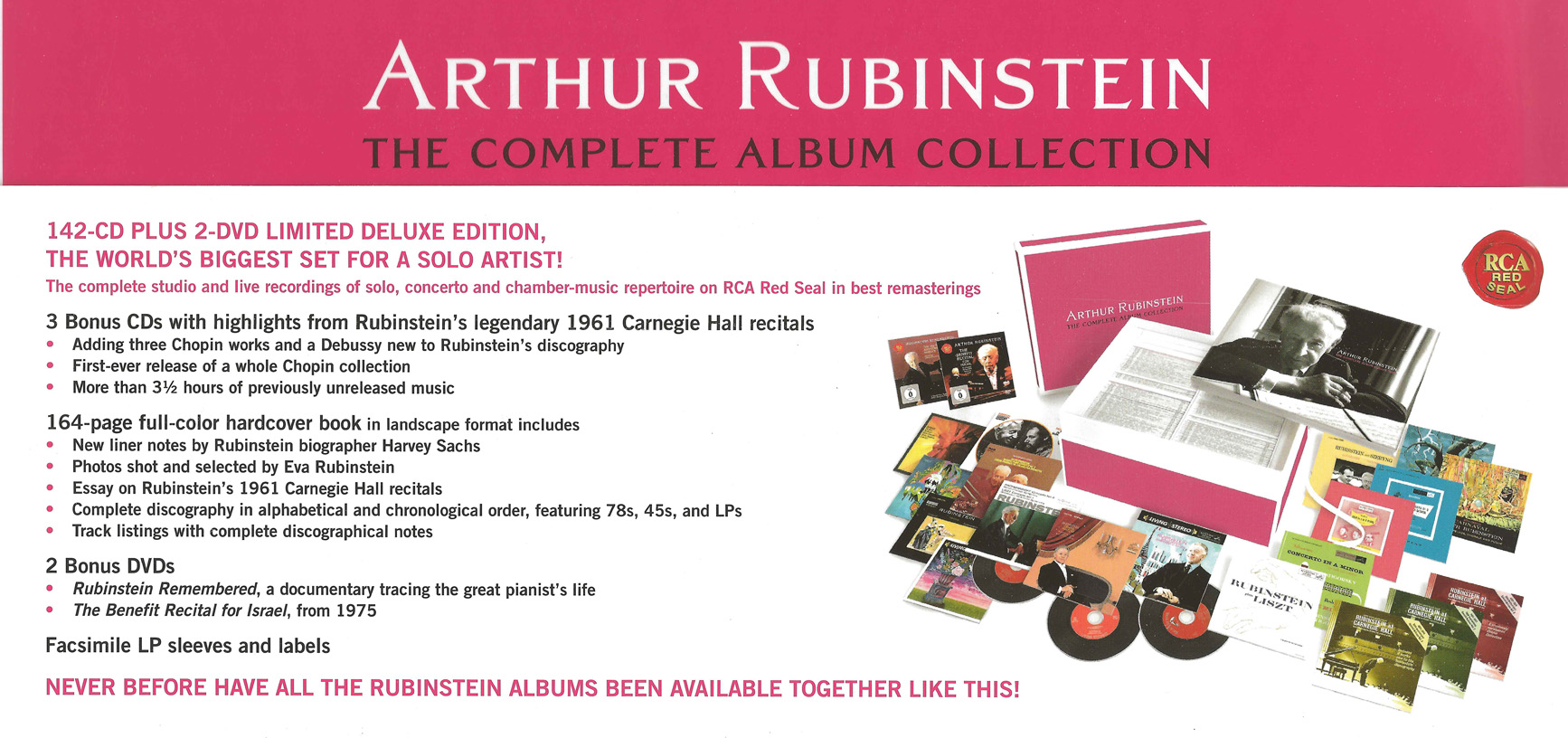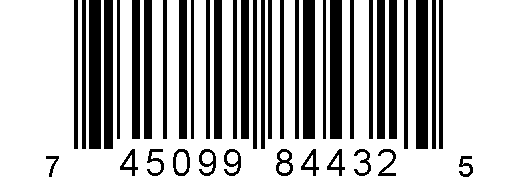Arthur Rubinstein
“The Complete Album Collection”
Media Review / Listening Diary 2014-04-13
2014-04-13 — Original posting (on Blogger)
2014-11-11 — Re-posting as is (WordPress)
2016-07-19 — Brushed up for better readability
Table of Contents
Introduction — The Rubinstein Album Collection
Two weeks ago, I received a very generous gift from my former colleagues: “Arthur Rubinstein — The Complete Album Collection“, in a “limited deluxe edition”. It’s a heavy box with 142 CDs and 2 DVDs, presumably with all recordings that Arthur Rubinstein (1887 — 1982) ever made with RCA Red Seal in his long career (the recordings span the years from 1937 up to 1976).
Gross Overview on What’s in the Box
This is an impressive, nice box, featuring
- 14 CDs with early recordings from 1928 – 1949 that originally were released on 78’s; obviously, the CDs were filled with recordings from multiple 78’s
- 41 CDs with mono recordings from 1946 – 1957 that originally were released on LPs; the CD sleeves are detailed replicas of the original LP covers (front and back)
- 83 CDs with stereo recordings from 1956 – 1976 that originally were released on LPs; again, the CD sleeves are detailed replicas of the original LP covers
- 1 CD with interviews with Arthur Rubinstein, recorded in 1965
- 3 CDs with concert recordings from Carnegie Hall, recorded in 1961
- 1 DVD featuring Rubinstein’s benefit concert for Israel on January 15, 1975
- 1 DVD “Rubinstein Remembered, the 100th Anniversary Tribute“, hosted and narrated by John Rubinstein

Packaging, Documentation
As mentioned, most CDs are meant to be remastered replicas of LP recordings. The “packaging” therefore was left untouched, i.e., it was not tried to fill all CDs to 70 – 80 minutes. The CDs retain the original overall duration from the LPs. Not only the CD sleeves are replicas of the LP sleeves: the CDs themselves are made to look like little LPs (or 78’s), and in the center they carry a label in the style of the original LP or 78’s label. In addition to the actual media, there is a nice, hard-bound, 162-page documentation / book, featuring
- p.1 – 67: illustrated documentation of Arthur Rubinstein’s life, including a 10-page timeline
- p.68 – 128: illustrated, detailed track listing, showing the CD covers
- p.129 – 146: alphabetic listing of compositions, by composer
- p.147 – 159: chronological listing of recordings
A Nice Gift!
All in all, a very nice gift (thank you so much, my dear colleagues & friends!), and completely unexpected to me! It would not have occurred to me to acquire such a complete collection, mainly because of the inherent, inevitable duplication — which turns out to be minimal in this case. More importantly, Rubinstein is a very interesting artist (not just for his very entertaining first autobiography “The Early Years”!), and this box is a treasure full of interesting recordings, even for people such as myself who have largely switched their focus to historically informed (HIP) recordings!
Memories About the Artist
Plus, I have good memories of a late concert by Arthur Rubinstein at the Tonhalle in Zurich, where he played the Mozart concerto in D minor, K.466 (I didn’t know that piece inside out yet at that time, but recognized that the cadenzas could not have been written by Mozart — and indeed he played the Beethoven cadenzas for this concerto). I also remember watching the documentary movie about the artist (“The Love of Life”, from 1969. I just only realize that the film is now available on YouTube; should watch that again! Even though it must have seen it be 35 — 40 years ago, I still remember many details and sequences from it.
How to Listen to so much Music?
I do not plan to listen to all this in the order of the CDs: the box contains multiple pieces that Rubinstein has recorded tree, if not more, times; I’m therefore in the process of ripping all CDs into my computer. This makes it far easier to pick all recordings of a given piece, and comparing them with the other interpretations in my library. And so, these recordings will be included in upcoming posts, as I see fit. Note that numerous of these recordings are of course also available independently. I will not be looking for such stand-alone CDs, but just mention the recording from this collection.
Once I’m done with ripping the 141 music CDs, I’ll post an overview over the music covered in this box; at this point, let me just mention that Rubinstein was rather specific in his repertoire:
- there isn’t a single, original composition by Bach,
- close to no Haydn,
- 5 concertos and a mere 3 additional compositions by Mozart,
- all concertos (all several times), 7 out of 32 sonatas, very few pieces of chamber music by Beethoven, and
- a narrow selection of Schubert,
- very broad, but not complete coverage of Chopin, and
- he remains selective up to Rachmaninoff and Stravinsky, etc.
Rubinstein was not an “encyclopedic” artist, for sure, but that leaves the expectation that the compositions that he selected were those that suited him well, i.e., there’s at least the potential, and maybe the expectation that the pieces he chose profited from his restricted selection?
Artur vs. Arthur?
Note that Arthur Rubinstein was born as Artur Rubinstein. He later changed his first name to Arthur. I’m now using the latter version, Arthur.
Exploring the Fringes of Rubinstein’s Recording Repertoire…
Busoni vs. Bach?
Apart from introducing this “Complete Album Collection” as such, I wanted to start discussing its content, beginning with a piece that Rubinstein recorded only once, in his early years (1934): Ferruccio Busoni’s piano transcription of Johann Sebastian Bach’s “Toccata, Adagio and Fugue” in C major (BWV 564), BV B 29/1:
Arthur Rubinstein
Arthur Rubinstein — The Complete Album Collection
CDs #1 – 5: The Early Recordings 1928 – 1935
SONY Classical 88691936912 (142 CDs / 2 DVDs, mono / stereo); ℗ / © 2011
Documentation 162 pp., track listing on CD sleeve

There are no other recordings of this transcription by Arthur Rubinstein in the Album Collection, nor do I have any other interpretations of this piece on the piano. But of course I have it played on the organ, the way it was composed by Bach: after all, this is my favorite organ piece by this composer! Here’s my favorite interpretation, by Ton Koopman:
Ton Koopman, Organ
J.S.Bach: Organ Works, vol.4 — BWV 532, 538, 540, 564, 565, 566.
Ton Koopman, Arp Schnitger-Organ, St.Jacobi Church, Hamburg
Teldec Das Alte Werk 4509-98443-2 (CD, stereo); ℗ / © 1996
booklet 40 pp., e/d/f/dutch

How Does Busoni’s Transcription Compare to Bach’s Original?
Well, the short answer — frankly — is that it does not compare!
Ferruccio Busoni (1866 – 1924) was one of the pre-eminent piano virtuosi of his time. At the same time, he also was composer, conductor, editor, writer, and piano teacher. His music isn’t very well known these days, but his transcriptions of works by Bach and others are still occasionally played; his most famous transcriptions is that of Johann Sebastian Bach‘s Chaconne (Ciaccona) from the Partita for solo violin in D minor, BWV 1004. From the same composer he also transcribed the famous organ piece Toccata, Adagio and Fugue in C major, BWV 564.
In the case of the Chaconne, he didn’t just do a 1:1 transcription, but freely added bass doublings, harmonizations, etc.; he transformed Bach’s composition into one adapted to exploit the full sound of a concert grand.
Transcribing Organ Music for the Piano
Now, the Toccata, Adagio and Fugue in C major is an organ composition. A work which Bach must have written to expose his eminent abilities on the instrument, particularly in the pedal solo in the Toccata. More than many other of Bach’s organ compositions, this piece exploits the majestic side of the organ the power of the big, deep pipes. In the Chaconne for solo violin, Busoni can make the sound richer & greater on the piano. However, there is no “making greater” or “making bigger” when doing this to an organ piece: the piano does not come near the richness and power of the organ sound. Also, one also misses the stunning effect of a virtuosic pedal solo, or these powerful bass interjections on the organ!
A modern concert grand (e.g., a Bösendorfer 290 Imperial) might be able to play very deep notes, too — but these are at the edge of the range, and they are percussive. Organ pipes can be build to cover an almost arbitrary tonal range (deeper or higher than the human ear can hear), and their sound is continuous, not percussive. There is simply no way to imitate that sound on the piano. Busoni tries his best with bass doubling, or having the left hand play heavy chords, and the pedal interjections are “imitated” with “loaded” tremoli in both hands. So again: in the case of organ compositions, there simply is no fair comparison between Bach’s original and Busoni’s transcription.
Conclusions
Conclusion: I definitely invite you to enjoy Bach’s original version of BWV 564 — my favorite interpretation is shown above. On the other hand, Busoni’s transcription is worth hearing as well: it’s an interesting work by itself and in its own right. But you will have more pleasure listening to it if you don’t first listen to Bach’s original! Rubinstein’s interpretation is very good, virtuosic, but not limited to virtuosity. The artist was 47 at the time of this recording, hence at the height of his pianistic abilities; yet, I would say that he did not play this as a pure virtuoso piece, but is presenting this transcription as a fascinating piano composition!
Note that there is at least one earlier recording of BWV 564 with Ton Koopman, and I also have one other interpretation of that work. For details see my “Listening Diary 2012-10-02“.
Listening Diary Posts, Overview






